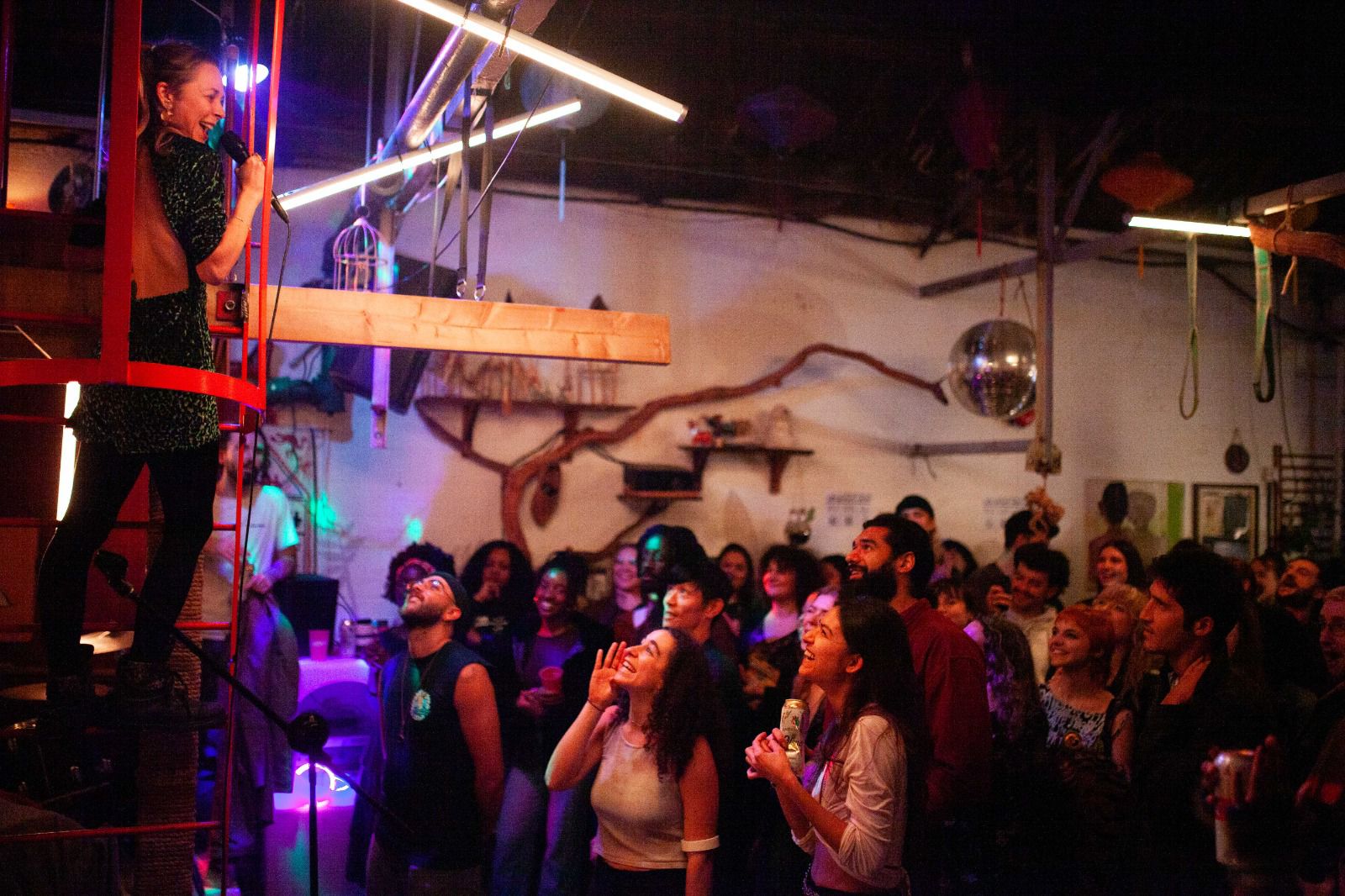Honor Oak: The radical history of the London suburb fighting the far-right
This year, locals of the south-east London suburb have hit back spectacularly against the far right - but their neighbourhood has a long and vaunted progressive history.
"The first demo felt like a massive victory," says local activist Amardeep Dhillon, reflecting on the Saturday morning in February that saw south east London suburb Honor Oak become a frontline in the fight against fascism.
This gathering in support of a Drag Queen Story Hour hosted at the Honor Oak pub, which far right protesters had chosen to target, was a day of jubilation and triumph — despite the hatred spewed by one side. Blue, pink and white banners flew high, and generations came together in support of social justice. "We outnumbered the far right by more than ten to one," Dhillon says. "It was a resounding humiliation."
And yet, throughout 2023 right-wing activists from Turning Point UK have continued assembling to protest against the drag storytelling event. They've been joined sporadically (and on some weekends swamped) by self-proclaimed fascists and Nazis from groups like Blood & Honour and Combat 18. Each time they've gathered, this collection of bigots has been met by fierce opposition from hundreds of local people, including Dhillon.
"Turning up to defend Drag Queen Story Hour constituted new forms of hyper-local community and new community connections," said Dhillon. "It wasn't just queer people, or the activist scene and militants; it was the wine mums, parents with kids… old Trots and young liberals, everyone you could possibly imagine. There was a strong union presence, and the local church was getting involved. That felt amazing."
The defence of the Honor Oak has shone a spotlight on this quiet suburb, which straddles the border between Lewisham and Southwark. In a climate of intolerance, where prominent politicians such as Rishi Sunak and Suella Braverman have continually attempted to fuel and legitimise the anti-trans agenda of the far-right while being aided by the mainstream media, this unassuming part of the capital has become a key battleground. But this isn't exactly a first. Honor Oak's status as a site of anti-establishment protest dates back centuries.
Honor Oak: The Early Days
The name 'Honor Oak' originated in 1602, when, according to legend, Queen Elizabeth I enjoyed a picnic with the Welsh courtier Sir Richard Bulkeley while nestled under a tree in a patch of elevated woodland now known as One Tree Hill. The tree was subsequently named the 'Oak of Honor', and as the centuries passed, the surrounding area was handed the same title.
Few people lived in Honor Oak and neighbouring Forest Hill until 1836, when the doomed Croydon Canal scheme was abandoned and the waterway converted into a railway line serving the remoter stretches of south east London. Until then, much of the area was dominated by the Great North Wood, most of which is now gone. One surviving woodland spot is the aforementioned One Tree Hill, a public park packed with London planes and poplar trees, offering distant glimpses of the central London skyline. But push beyond the natural beauty of One Tree Hill, and you'll find a fascinating history of radical resistance.
"This was a hotbed of radicalism," says local historian Mike Brown of Crofton Park History. "All sorts of trade union leaders lived around here, partially because a lot of the radical leaders were educated, and in those days that meant you were almost certainly middle-class. Because of the new railway line, this was a middle class area… you could get to your clerical job in the city and then come back to this green, leafy area."
Over the years, rumours — fueled in part by local councillor John Nisbet's 1905 text 'The Story of the "One Tree Hill" Agitation' — have circulated that Honor Oak was the site of the Iceni Queen Boudica's eventual defeat by the Roman general Suetonius Paulinus, following her uprising against Britain's colonial rulers in AD60-61.
But according to Brown, these are just "myths and legends… locals getting free drinks out of the 'townies' [on the coaching road to London] by spinning yarns." Apparently, the same can be said for stories that the second-largest popular uprising of the 15th century, Jack Cade's 1450 Rebellion, passed through the area. The revolt saw roughly 5,000 working-class citizens march on London from Kent to protest against the corruption and tyranny of King Henry VI's government, and while nearby Blackheath was a key meeting point, there's no evidence the rebellion touched Honor Oak. But that hasn't stopped stories circulating. It also takes nothing away from the realities of the area's radical tradition.
The Red Flag
Let's fast forward to the middle of the 19th century, when things are a little more concrete; the Croydon to London railway has just been built, and across the Irish Sea, a man has been born who will make a unique contribution to the language of British radical politics.
"The image of the 'red flag' is thought to have struck Connell while en route to Honor Oak, observing the train guard stationed on the platform, as he raised and lowered the red signal flag."
Jim Connell was born and raised in County Meath, moving to Dublin at the age of 18. Having cultivated strong socialist principles and joined the Irish Republican Brotherhood as a teenager, he ultimately lost his job as a dockworker in the Irish capital after attempting to unionise the workforce. Not long after, Connell came to London.
It was on a train home from Charing Cross to Honor Oak in 1889 that Connell composed possibly the most famous socialist anthem in history. Inspired by the London Dock Strike of 1889, which mobilised 100,000 workers in a hugely symbolic victory for casual, poorly-paid dockside labourers, he penned a poem that remains incredibly relevant across the global labour movement.
"So raise the scarlet standard high / Beneath its shade we'll live and die / Though cowards flinch and traitors sneer / We'll keep the red flag flying here," goes the chorus of 'The Red Flag', a rousing ode to the power of collective action and community solidarity.
The image of the "red flag" is thought to have struck Connell while en route to Honor Oak, observing the train guard stationed on the platform, as he raised and lowered the red signal flag.
"In writing the song I gave expression to not only my own best thoughts and feelings, but the best thoughts and feelings of every genuine socialist I knew," wrote Connell in his 1920 text 'How I Wrote The Red Flag'. And, despite the gaping absence of any genuine socialist politics amongst the top brass at Labour's 2023 Party Conference, the event upheld the historic tradition of playing 'The Red Flag' at the close of conference. It's a testament to the continued power of Connell's anthem.
Today, his legacy is marked by a plaque on his former home, a red brick Victorian terrace on Stondon Park. Part of Lewisham Heritage's Maroon Plaque Scheme, founded in 1974 to pay tribute to people of local interest, the slab of metal outside this residential property underlines the role Honor Oak has played in shaping the history of socialism.
A question of sport (specifically, golf)
A few years after Connell wrote his famed socialist anthem, Honor Oak played host to an anti-establishment uprising that further reinforced the area's radical reputation. It was 1897, and one of the borough's most cherished public spaces was at risk of being snatched away from the local community.
One Tree Hill was a valued green space, a so-called 'waste' land where "people could go and gather sticks, or go for a walk, or take a few pigs," according to historian Clive Bloom, whose book 'Violent London: 2000 Years of Riots, Rebels and Revolts' traces the capital's radical history. As a result, when the owner of this "common land" attempted to sell up to a local golf club and barricade the public from entering using a six foot fence, it caused an explosion of public outrage.
The extent of the ensuing uproar is staggering in hindsight. Immediately, the 'Enclosure of Honor Hill Protest Committee' was formed, which quickly grew to around 150 members. A motion to pull down the fence was soon introduced and subsequently defeated by the committee, but while the organisation searched for a constitutional resolution, local residents took matters into their own hands.
On 10 October 1897, thousands of protesters gathered and broke down sections of the golf course fence. A week later their numbers reportedly trebled, and over the following weeks the protests continued to grow. Some accounts estimate that certain demonstrations were attended by 50,000 people.
"There was a huge movement by the end of the 19th century to save the infrastructure of England's forests and green spaces, and they weren't really interested in the political message, they were interested in preserving traditional England," says Bloom. However, these activists were outnumbered by "working-class protesters [who] might have been interested in the natural world, but it's more likely they were interested in communal rights and what "the people" were entitled to. It was very much the community versus the individual entrepreneur."
"This was a period when social unrest was rife across Europe," adds Brown. "There were a lot of fears amongst the ruling classes about potential revolutions." Partly due to this context, the police soon responded violently to the public protests at One Tree Hill. Here, it makes sense to draw parallels with the 2023 Honor Oak protests.
"The police deem[ed] our presence on the road to be a disruption to the local community and impose[d] Section 14 conditions, but they didn't stop the fascists from being on the road" says Dhillon, recalling the June demo in which police responded to demonstrations with force and arrested him and others on the scene. Unsurprisingly, Honor Oak's radical tradition has repeatedly caused clashes with authority.
The One Tree Hill protests were eventually resolved when Mr. Charles William Tagg (Town Clerk of the new Borough of Camberwell) purchased the land from its owner (Mr J. E. Ward) for it to be donated to the borough. After years of what Nisbet describes as "agitation" (and plenty of behind-the-scenes negotiation), Honor Hill was sold and reopened as public land in 1905. It remains as such today.
Honor Oak today
"The sheer number of people willing to turn up and show solidarity with marginalised groups in Honor Oak breeds hope."
There are major differences between the agitation of 1897-1905 and the modern demonstrations that have seen activists like Dhillon attacked by far-right thugs for defending trans rights. But there are also important parallels, not least the continuation of the suburb's radical fighting spirit, and the widespread understanding of the importance of social justice.
"People thought it was unfair when these spaces were enclosed, because of the tradition of people being able to use this space without let or hindrance" says Bloom of the Honor Hill demos. "You have this disconnect between people who want a green space… and the greed of capitalism. A lot of the people who were involved in the One Tree Hill protest dressed up wilfully in flat caps and artisan clothing to make it clear that they were working-class and that this was a fight between the classes."
Today, the sheer number of people willing to turn up and show solidarity with marginalised groups in Honor Oak breeds hope. This is in spite of the fact that Drag Queen Story Hour is currently on hiatus, which according to Dhillon means the far right “managed to achieve their objective”. There are reasons to be hopeful, however.
"Because of what's happening in Palestine, the terrain has changed unimaginably," Dhillon says. "The fash are currently dealing with mass arrests, so it's quite complex to say whether they have been emboldened. For nine months, we prevented the far right from marching unopposed and from taking the pub and stopping the event from going ahead. That is a victory."
It's a victory that highlights the power of public unity in the face of right-wing hatred and violence. It's also a victory that helps shine a light on the radical history of a fascinating part of London.
The Lead is now on Substack.
Become a Member, and get our most groundbreaking content first. Become a Founder, and join the newsroom’s internal conversation - meet the writers, the editors and more.





